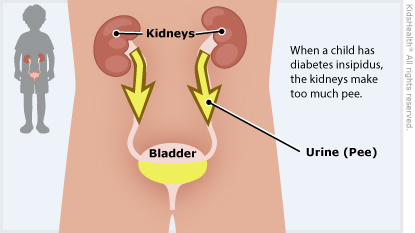In nephrogenic (nef-reh-JEN-ik) diabetes insipidus, the body loses too much water because of a problem with the kidneys. Normally, the kidneys help balance the amount of water and salt in the body. A child with nephrogenic diabetes insipidus may pee a lot, wet the bed, be thirsty often, or get dehydrated. Changing the diet and taking the recommended medicines can help.



Your child:

Your child:

Is nephrogenic diabetes insipidus the same as diabetes mellitus? Nephrogenic diabetes insipidus is not the same as diabetes mellitus ("sugar diabetes"). Although the body may make too much pee in both conditions, the two are different and need different treatment.
How does nephrogenic diabetes insipidus happen? Nephrogenic diabetes insipidus often runs in families and is caused by genetic mutations (changes). It also can happen if a child has another health problem or takes some types of medicines. Health care providers do testing to learn more about the cause.
How is nephrogenic diabetes insipidus treated? Health care providers may refer a child to a specialist. Treatment includes medicine and sometimes a low-salt diet. These can help the body make less urine. If another health problem is causing diabetes insipidus, the health care provider will treat it.